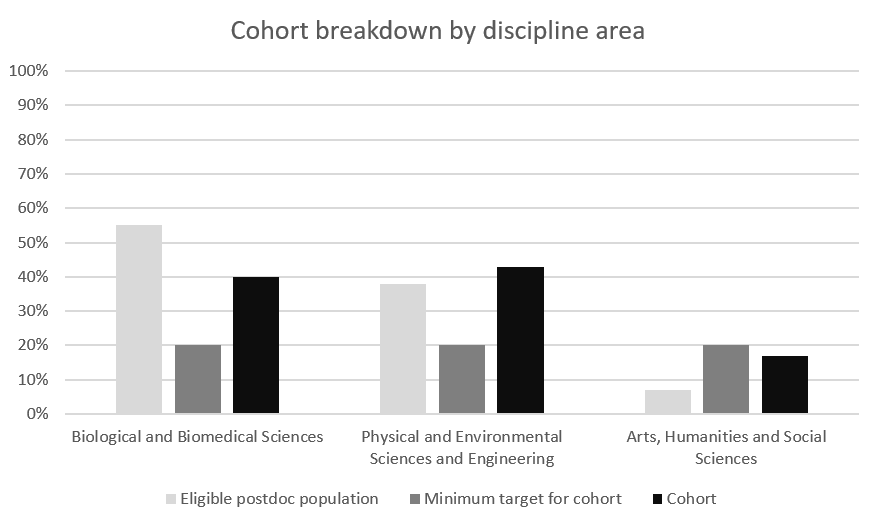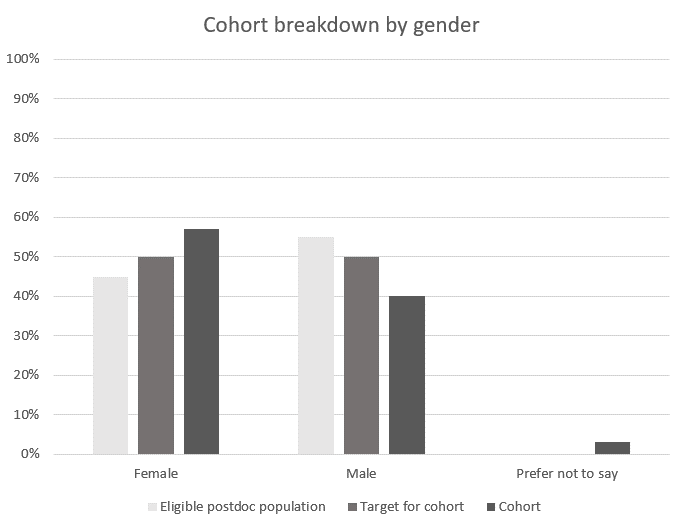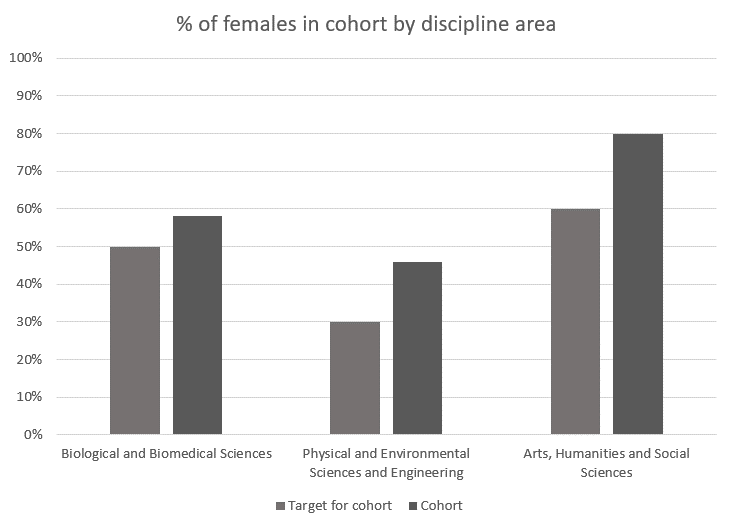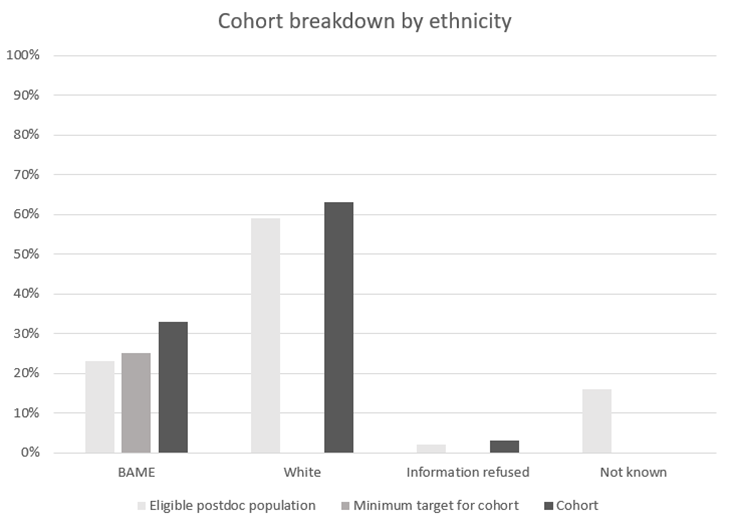Reflections on recruiting Prosper's first business-as-usual cohort at the University of Liverpool
Posted on: 14 March 2024 by James Reynolds in Blog posts

Following the success of our Research England Development funded pilot cohorts, and with our UKRI-funded rollout to the wider sector ongoing, we are now embedding Prosper as part of ‘business as usual’ within researcher development at the University of Liverpool (UoL). Our first cohort in this new phase kicked off on 13th February 2024.


30 postdocs gathered in the library space of the School of Arts for the induction, giving them a chance to meet and get to know one another, as well as to share their concerns and hopes for the six-month programme ahead.
The timing of the pandemic meant that our pilot cohorts had to be conducted almost entirely online – so it was lovely to finally be able to commence a cohort with an in-person event.
With the cohort now in full swing, we thought it an opportune moment to reflect on the recruitment process and final makeup of the cohort – with a particular focus on the efforts we took to ensure diversity according to discipline, gender and ethnicity.
The recruitment process
We were looking to recruit 30 postdocs and we aimed to keep the application process as simple and inclusive as possible.
Anyone employed by the UoL on an academic research-only (ARON) contract grades 6-9 was eligible to apply. Due to the shorter timeframe of the cohort as compared with our pilots (six months vs. a year), we dropped our previous requirement of postdocs needing at least six months left on their contract.
This meant that 854 postdocs across the university were eligible to apply for the cohort. Applicants simply had to submit two short motivational statements, one explaining their understanding of the Prosper model and cohort, and one making the case for why Prosper would be beneficial to them at this juncture in their career. We advertised the cohort as widely as possible across faculties and departments and held informal online drop-in sessions where potential applicants could come and ask us any questions.
Ultimately, we received 67 applications (with all 67 deemed eligible), more than double the number of places available, and representing around 8% of the eligible postdoc population.
Ensuring a diverse cohort
In order to select the final 30 in a fair way, the applications were anonymised, and then scored by a panel that included members of the Prosper team, both the broader Researcher Development and Culture team and the Diversity and Equality team within the Academy, as well as postdocs from the Research Staff Association. Scores were based on the two motivational statements – our diversity criteria were then only used to break any ties.
Prosper is committed to breaking down the various barriers that postdocs face when it comes accessing quality career development resources, and ensuring that all postdocs – regardless of discipline, gender or ethnicity – can reap the benefits.
Accordingly, we set diversity targets for recruitment that matched those we used in our pilot cohorts:
- At least 20% representation from each of three broad disciplinary areas below
- An overall 50/50 gender representation in the wider cohort, with further targets by disciplinary area due to gender skews in the postdoc population in those areas:
a. Biomedical and Biological Sciences – 50% female, 50% male
b. Physical and Environmental Sciences and Engineering – 30% female, 70% male
c. Arts, Humanities and Social Sciences – 60% female, 40% male - A minimum of 25% representation of postdocs from ethnically minoritised groups, including:
a. Postdocs from Black, Asian and other minority ethnic (BAME) groups
b. Postdocs with dual heritage/mixed ethnic backgrounds
Note regarding the ‘BAME’ category: We are aware of the controversy and unease around using the term and category of BAME, but our use was necessary in this instance as we are comparing broad categories, with a small number of individuals where a more granular breakdown could risk data becoming identifiable (see this guide from the Law Society for more information about issues with the term, and contexts that justify its usage).
Makeup by discipline
The final cohort makeup according to the three disciplinary areas (and compared with the wider proportion in the overall UoL postdoc population) is as follows:

- Biomedical and Biological Sciences – 40% of the cohort (55% of the wider UoL postdoc population)
- Physical and Environmental Sciences and Engineering – 43% of the cohort (38% of the wider UoL postdoc population)
- Arts, Humanities and Social Sciences – 17% of the cohort (7% of the wider UoL postdoc population)
The final proportion of postdocs from the Arts, Humanities and Social Sciences fell just short of our 20% target. Nonetheless we are pleased with how close we came, and the extent to which we have succeeded at including an oft-under-represented postdoc group – especially given it only comprises 7% of the wider eligible UoL postdoc population.
Makeup by gender
The final makeup of the cohort by gender is 57% female, 40% male, with 3% preferring not to say. By comparison, the wider eligible UoL postdoc population is 45% female and 55% male:

Thus, females are over-represented in the cohort overall, both in relation to our targets and the eligible postdoc population at large. This follows the pattern we observed in recruiting our pilot cohorts, and our wider experience that females tend to engage with career development opportunities more readily than their male counterparts. This trend is more broadly observed and noted across the sector.
The same pattern of female over-representation can be seen in the breakdown by disciplinary area:

- Biomedical and Biological Sciences:
o Target: 50% female, 50% male
o Cohort makeup: 58% female, 33% male, 8% prefer not to say - Physical and Environmental Sciences and Engineering:
o Target: 30% female, 70% male
o Cohort makeup: 46% female, 54% male - Arts, Humanities and Social Sciences
o Target: 60% female, 40% male
o Cohort makeup: 80% female, 20% male
Previous research has attributed the increased participation of women in career development programs to them seeking out sources of career advice and support to counterbalance wider inequalities (see also here).
Makeup by ethnicity
The cohort makeup by ethnicity, in comparison to the wider eligible UoL postdoc population, is as follows (as previously noted, we are using the BAME category solely for the purposes of maintaining anonymity given the small size of the cohort):

- BAME – 33% of the cohort (23% of the wider UoL postdoc population)
- White – 63% of the cohort (59% of the wider UoL postdoc population)
- Information refused – 3% (2% of the wider UoL postdoc population)
- Not known: 0% (16% of the wider UoL postdoc population)
Thus, we comfortably exceeded our minimum 25% target for recruiting BAME postdocs to the cohort, and the group is well-represented in the cohort in comparison to the eligible population.
Looking ahead
Overall, we are very pleased with both the level of interest and engagement shown during the application window, and the diversity of the final makeup of the cohort across our criteria. We’re excited about the journey we’ll all be sharing in the months ahead.
We will of course be continuing to track metrics for evaluative purposes and build on lessons from this recruitment process for future cohorts to come. We will also be sharing our learnings and experience of running the cohort with other institutions as part of our UKRI-funded work towards building a sustainable, inclusive model of postdoc career development for the whole sector to adopt.
(Some of the sessions the cohort will be undertaken are also freely available to all postdocs at the University of Liverpool – click here for more information, timings and to register).
Keywords: Postdoc, Prosper, Recruitment, Postdoctoral researcher, Prosper cohort.